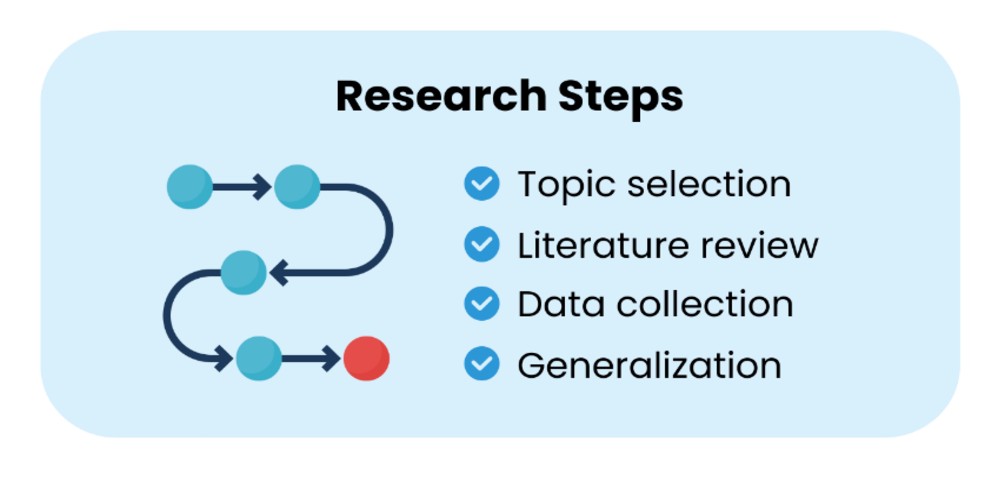In the digital age, finding accurate and reliable information is more accessible than ever, thanks to a variety of research tools. For students, it is especially important to choose sources attentively and not to fall for misinformation. On this page, we offer a list of online research tools for students that will come in handy whether you’re working on a school project, writing a thesis, or preparing for exams. Read this article and discover excellent research platforms that will make navigating vast amounts information easier.
In this essential list of free online research tools compiled by our expert custom writers, you will find:
- Topic generation tools
- Online research tools for literature reviews
- Data analysis and visualization tools
- Tools for organizing your research process
1. 👣 Doing Research: Key Steps

Regardless of the subject field, all research has a similar structure. Such an approach facilitates the mutual understanding of scientists from neighboring or even distant domains. As a rule, scientific texts are challenging to write and read. That is why you need to observe the following procedure.
- Topic selection. Surprisingly, this is the most creative part of a research project. The subject area shall be topical and relevant, and the title must be concise and informative.
- Literature review and concept development. To write something new, you need to know what has already been written by other scientists. Study the available literature on your subject and define what statement or concept you will defend in your research.
- Empirical part: data collection and analysis. Accumulate the evidence to support your thesis statement.
- Conclusions and recommendations. Any research finishes with generalizations of the findings. You can as well give general suggestions for your successors in research. At this step, online summarizer would be a highly effective tool.
The following sections provide you with tools and techniques to facilitate each of the four stages. There is also a list of tools helping to organize the entire research procedure.
2. 💡 Topic Generating Tools
In science and academia, nobody receives a ready-made topic to work on. As a rule, you are given a direction in which you should look for an unexplored field of knowledge. With this direction in mind, you can brainstorm a compelling topic that would be engaging. There are multiple tools to make the task an easy one.
- Lucidchart.Lucidchart is an excellent instrument based on infographics. The diagrams in this software help to understand people’s behavior, data, and processes. The visualization allows to find out the interdependence between different phenomena. If you have a large bulk of information to process before generating a topic, this should be your choice.
- Mind42. Mind42 is a free (ad-supported) mind mapping tool. Structure your notes here for further reference. It works as a block diagram, where units of information are connected with arrows. It is user-friendly, so you will not waste much time on preparations.
- Visual Thesaurus. This one is more about the formulation. If you have come up with a topic, but struggle with its wording, visualize it with the tool. The tool gives you a list of word associations and their relationships. Considered by many to be the best thesaurus online, the service is excellent for theoretical research as it builds word maps, provides their meanings, and suggests related terms.
3. 📚 Research Tools for Making a Literature Review
3.1. Research Databases
So, you have created a word document and noted the title. What next? You should look for the most authoritative works in the required sphere. How do you know which ones are the most influential? There are online research tools that create lists of the most cited scientific articles.
- Google Scholar. The same company that produced the world’s top search engine also offers the world’s top scholarly search engine. Google Scholar works just like Google. But it directly links you to only publications in countless academic journals. When using the system, look at the right-hand side of the search results. There, Google Scholar shows you if a PDF is available for each article.
- LexisNexis. This is the research resource of choice for law school students and lawyers. Of course, this is an expensive service for individuals. But your school may have free access.
- Scopus. Scopus is a bibliographical base used by over five thousand academic, governmental, and corporate establishments. It searches through about 75 million entries, including 194’000 books. You can search by author, document title, or affiliation. It shows the citation rate of almost any article from any discipline. The tool also suggests similar documents by related references, which could accelerate your research.
- Web of Science. WoS is a multidisciplinary citation database trusted by more than 9 thousand institutions. It allows for the historical tracking of research questions in all spheres of knowledge. 9.1 billion cited references would suffice for the most exigent researcher. Web of Science can be used as a resource to find trusted materials in the public domain.
3.2. Digital Libraries
Once you have found enough references, you need to study them. Visiting conventional libraries is often a waste of time since many contemporary research documents are accessible on the web. Digital libraries are usually paid web research tools, but many universities and colleges purchase a subscription for their students.
- Google Books. Google Books was launched in 2004. Today, it offers full-text searches of over 25 million books. That’s a lot of reading!
- The US Library of Congress. As a leading research library, the Library of Congress has an incredible number of online resources. Their website lets you search for nearly every book ever written. You can also skim their vast online collections.
- Project Gutenberg. The goal of Project Gutenberg sounds crazy. They aim to digitize every book that is not under copyright. In brief, they offer almost every classic book published before 1900.
- JSTOR. This database searches for books, primary sources, and journals. It provides free access to open community collections of museums, public libraries, and archives. The resource has a special offer due to COVID-19 displacement of students, offering free use of unlicensed materials. Still, only the participating educational institutions are eligible. You can share your lists with other users if you wish.
- ScienceDirect. ScienceDirect focuses on medical, technical, engineering, and scientific research, but humanities are also covered. It provides access to foundational and theoretic materials and the latest findings. You can search by keywords, author, title of book or journal, volume, issue, and page. All the literature is peer-reviewed and can be trusted.
- ResearchGate. ResearchGate provides more than 135 million publication pages. The tool is an excellent solution to keep up with the latest research news. It allows sharing your research with peers, collaborating with them across the continents, and asking for expert support. You can as well track how many people have read or referenced your work.
- Wiley Online Library. Here you can access an extensive collection of books and reference resources during 48 hours on a pay-per-view basis. Many articles are available for paid download for lifetime use. It can be done without a subscription. Through this resource, you can find reliable user guides, training videos, and webinars.
3.3. Discipline-Oriented Libraries
If you are working in a narrow scientific field, multidisciplinary libraries may not meet your expectations and needs. Besides, if various disciplines discuss your research question, the search for references becomes a daunting task. Then you should explore discipline-oriented libraries. They function just like any other digital library but provide access to works in only one area of knowledge.
- Project MUSE. Johns Hopkins University hosts this web resource. It mainly focuses on digital articles and book chapters on humanities and social sciences.
- PubMed Central. The U.S. National Institutes of Health’s National Library of Medicine offers PubMed Central. This is a free source for almost 4 million academic articles on biology and medicine.
- IEEE Xplore. This is the place to start if your research focuses on any of the many engineering fields.
- arXiv. Cornell University’s arXiv is the most extensive collection of open-source papers in mathematical fields. Subjects range from physics to statistics and finance.
3.4. Dissertation Databases
Ph.D. theses are usually written by young scientists. They are interested in being cited as much as possible, as it raises their researcher’s status. For this reason, top universities allow free access to Masters’ and Ph.D. papers written by their students. You can use these databases in your research.
- PQDT Open. Proquest is the most extensive open-access dissertation database. It provides full-text versions of theses & dissertations on a range of disciplines.
- MIT Theses. This archive contains every dissertation and thesis completed at MIT since 2004. But some date back to the 1800s. The complete collection contains more than 50000 texts.
- Stanford University Libraries. The graduate work of over a hundred thousand Stanford students is searchable from anywhere in the world.
- UColorado Libraries. Since 1997, the University of Colorado has archived every one of their Ph.D. dissertations here.
- IDEALS. At the University of Illinois, students have the option of depositing their theses on IDEALS. And you have the option of searching for their dissertations!
- FAS Theses & Dissertations. Last but not least, check out Harvard’s archive of dissertations begun in 2012. It’s one of the most famous universities in the world for a very good reason.
4. 🔬 Research Tools for Data Analysis
Data analysis is an essential part of any empirical research. It requires discipline-specific skills and knowledge of research instruments. Below you can find just a small share of data analysis tools available online or downloadable for most operating systems.
- MS Excel. Many people know it, but few of us can use its functionality. Its principal benefit is that this program is available in the MS Office package. It is an old tool, but it is the best for simple statistics, customizable graphics, and data visualization.
- SPSS. SPSS or Statistical Package for the Social Sciences is the most popular statistical software among human behavior researchers. It allows for parametric and non-parametric studies, descriptive statistics, and graphic visualization of the findings. You can also write scripts for automated analysis or more advanced statistical research.
- R-project. This package is free and widely used in many disciplines. Its toolboxes (or plugins) simplify any data processing. The functionality is the best among similar software solutions. It requires a certain knowledge of coding. Still, you can discuss any issues with the extended community that builds and improves the package.
- Stata. Stata is more functional than SPSS but simpler than R. Detailed user guides and tons of valuable information on forums can help you resolve almost any issue. This paid software is available for any platform. It is user-friendly and easily automated.
5. 📈 Data Visualization Tools
When your research findings are ready, the worst thing you can do is pour all the statistical data on your future readers. Visualization of all those percentages, ratios, and correlations makes your paper engaging and easy to follow. Respect your reader’s time and try not to turn your research paper into a quiz.
- Google Charts. This is an excellent and totally free example of data visualization tools. Its interactive charts are explicitly designed to be embedded online. It offers a wide range of chart formats to choose from. The most significant benefit is its ability to work with dynamic data. However, Google Charts have limited support, namely tutorials and forum discussions.
- Tableau. Tableau astonishes with the number of data uploading options. Besides, it has a desktop, online, and free public versions. Unlike Google Charts, it has multiple video tutorials, so only the lazy will not master it. Still, its paid versions are expensive (about $70), and the public version does not permit you to keep your data private.
- Infogram. Infogram has a free version offering basic functionality and tiered pricing for the paid version. Its drag-and-drop editor is user-friendly and intuitive. The tool allows for interactive visualizations to be integrated into websites and apps. Its drawback is the small number of built-in data sources, as compared to other programs.
- D3.js. This is a free, open-source JavaScript library to manage data documents. People without programming skills can easily use software tools to create visualizations. Multiple types of charts and a customizable interface make it convenient and understandable. Still, programming knowledge will be beneficial when working with this software.
6. 📑 Tools to Organize Your Research Process
Good organization is something needed on every research step. Below is a list of the most useful organizational tools for scholars.
- Scrivener. This tool unites the functions of a typewriter, ring-binder, and scrapbook. The trial version lasts for 30 days and includes all the features of the full version. This period is enough to understand whether you enjoy working in this program and complete a short project. It provides you with multiple methods of how to enjoy your research.
- Zotero. This is a excellent option for theoretical research that includes numerous citations. It is an open-source program facilitating the process of quoting and indicating the sources. It also collects and structures your information. These structures are tagged with keywords, which is very convenient for large-scale projects. Zotero has a function that creates a bibliography in any citation style.
- Mendeley. Mendeley creates a personal library directly from your browser tabs and desktop files. In a few clicks, you can generate citations and references to your library list. It has a function of personalized recommendations to stay informed about the newest research results. Besides, here you can browse information about more than 5’000 funding organizations and their grants.
Most people work with the software they are used to, ignoring the new and more functional alternatives. It is often rewarding to invest your time into exploring a new tool than to research and write your thesis in the same old way. Share your opinion about the described instruments in the comments and suggest your favorite ones!
🔗 References
- Tools for Researchers: Augusta University
- Research Tools: Smithsonian Libraries
- Useful Research Tools: Oregon tech Libraries
- Tools for Researchers: University at Albany
- Conducting Research: WUSTL Libraries
- Organizing a Research Project: Duke University
- 15 Steps to Good Research: Georgetown University Library
- WRITING A RESEARCH PAPER: UW-MAdison Writing Center












Please, help me with a dissertation topic for my Ph.D. in Hospitality and Tourism Management.